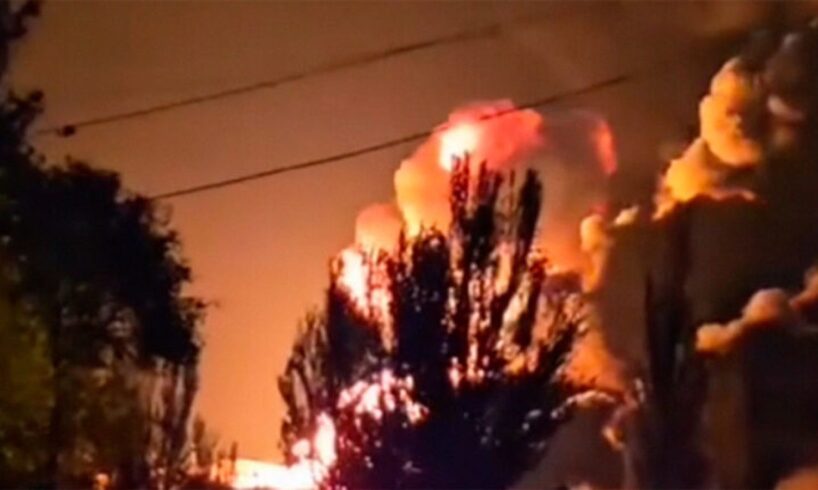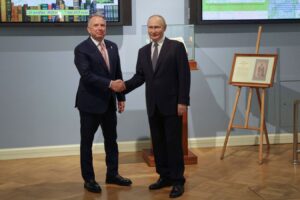
An explosion at the factory Avangard in the city of Sterlitamak in the Republic of Bashkiria, Russia, on October 17 took the lives of three workers. At least six more were wounded. Five of the wounded workers are still hospitalized, one of them in serious condition. The three workers who were killed were all women, one of them as young as 23. The other two leave behind children. Production at the facility, which produces ammunition and military equipment, continued despite the horrific disaster that destroyed an entire building.
The Republic of Bashkiria is located between the Ural Mountains and the Volga River. With around 280,000 inhabitants, Sterlitamak is the region’s second-largest city and an important industrial center, especially for the chemical industry.
Russian factory explosion [Photo: @strkoroche/Telegram]
While authorities have not given an official reason for the explosion, they have initiated a criminal case into the “neglect of safety practices.” Many Russian press reports declared that workers were to blame for the explosion. However, the governor of Bashkiria, Radii Khabirov, implicitly admitted that the disaster occurred due to outdated equipment. He acknowledged that “the factory is quite old but fulfills important tasks for the state.” He promised that the authorities would aid the factory with maintenance work.
Saturday’s explosion marks the third significant accident at the factory in just over a year. In early October, a female worker suffered severe burns from a fire. In August 2024, three workers died in an explosion during maintenance work.
The explosion is the latest in an unending series of factory disasters throughout the world. Just in the last 10 days, this has included an explosion at a Tennessee munitions factory in the US, which killed 16 workers, a garment factory fire in Bangladesh, which also killed 16, and a construction site collapse in Madrid, Spain, that killed four.
Almost 35 years after the Stalinist destruction of the Soviet Union in 1991 and the restoration of capitalism, Russia records a particularly high fatality rate for workplace accidents. According to official figures, as of 2024, Russia has about 3,000 to 4,000 work-related deaths each year, a ratio of five deaths for every 100,000 full-time workers. For comparison, in the US, where the WSWS has extensively documented industrial carnage, the official ratio is 3.5 deaths for every 100,000 full-time workers. Just recently, on August 17, a major factory explosion at a factory in the Riazan region took the lives of at least 28 workers, wounding over 100.
The latest factory explosion in Bashkiria sheds light not only on the industrial slaughter in Russia but also on the social relations prevailing in the country amid the war in Ukraine. Since the 2022 invasion of Ukraine by the Putin regime, which was deliberately provoked by NATO, Russia has geared much of its industrial production toward the war effort. The Avangard factory is one of many affected by this shift.
Founded in 1943, during the Soviet Red Army’s struggle against the Nazi invasion, the Avangard factory has long specialized in the production of equipment, parts and tools for Russia’s oil and gas industry, but it also produces explosives. Since 2022, it has shifted strongly toward military production and has significantly expanded its workforce. Now, the Avangard fulfills state orders for military equipment and weapons and the creation and modernization of ammunition. In 2023, it was taken over by the state-owned military giant Rostec, which is headed by Sergei Cheremezov, who is also a full member of the Russian Military Academy.
Cheremezov is a prime representative of the Russian ruling class, in whose interests the Putin regime invaded Ukraine. Like Putin, Cheremezov worked for the Soviet secret service, the KGB, the principal state agency tasked with defending the social privileges of the parasitic Soviet bureaucracy against the working class. Cheremezov and Putin met while both were working on KGB assignments in East Germany in the 1980s. Soon after the 1991 dissolution of the Soviet Union, Cheremezov, again alongside Putin, began to work for the administration of Boris Yeltsin, whose “shock therapy” plunged the vast majority of the working class into abject poverty.
In 2007, Putin appointed Cheremezov as the head of the newly formed Russian Technologies Corporation, now Rostec. A major conglomerate, Rostec oversees hundreds of facilities that form part of Russia’s large military-industrial sector. Cheremezov also serves on the board of several other major state-owned corporations, including Aeroflot Russian Airlines, and the oil giant Rosneft. Revelations by the Panama Papers indicate that over the course of the past decades, he and his family have amassed personal wealth of likely over $1 billion.
This wealth was accumulated on the backs and over the bodies of the working class. The oligarchy that arose out of the Soviet bureaucracy simply plundered the state assets that had been produced by the working class since the 1917 October Revolution.
A recent study by economists from the Moscow Higher School of Economists found that 66 percent of Russians earn below 40,000 rubles per month, or around $415. As of 2025, the combined wealth of Russia’s at least 146 billionaires amounts to $625.5 billion, with the top two billionaires holding fortunes of almost $29 billion each. This is the equivalent of 27 percent of the country’s GDP, a much higher level of wealth concentration even than in countries like Brazil, China or the US. These billionaires were able to increase their wealth by some $20 billion in 2024 and 2025, as hundreds of thousands of Russians and Ukrainians have been dying in a fratricidal war.
These same oligarchs have also allowed the relatively advanced industrial and social infrastructure of the Soviet period to fall apart, with deadly consequences for the working class. As in the case with Avangard, the overwhelming part of Russia’s industrial facilities still date from the Soviet era and have been extremely poorly maintained, a major reason for the high number of workplace accidents and fatalities. Because of the poor maintenance of housing stock, Russia also records one of the largest figures of fire-related deaths each year. In 2023, there were at least 7,500 fire-related deaths, 90 percent of them stemming from domestic and residential fires. The country’s fire fatality rate is 2.5 times the global average.
The Avangard factory fire is a stark illustration of the fact that the Putin regime invaded Ukraine not to protect the working class from imperialism but to protect the interests of the oligarchs against what they saw as unacceptable interference with their own profit interests by imperialism.
Now, the Putin regime is engaged in negotiations with the fascist Trump administration. Whatever their immediate outcome, these negotiations will neither resolve the existential threat posed by imperialism to the working class, nor the social devastation in both Russia and Ukraine. For the Russian working class, both the fight against imperialist war and the deadly social disaster it faces must proceed through a unified struggle with its class brothers and sisters in Ukraine, the US and across Europe, in complete independence from all factions of the oligarchy and imperialist powers.
Sign up for the WSWS email newsletter





